1st November 2012
The Larson family has been working in the forests of British Columbia since at least 1929, when Ivar and Lance’s grandfather started his first logging business.
— Paul Iarocci
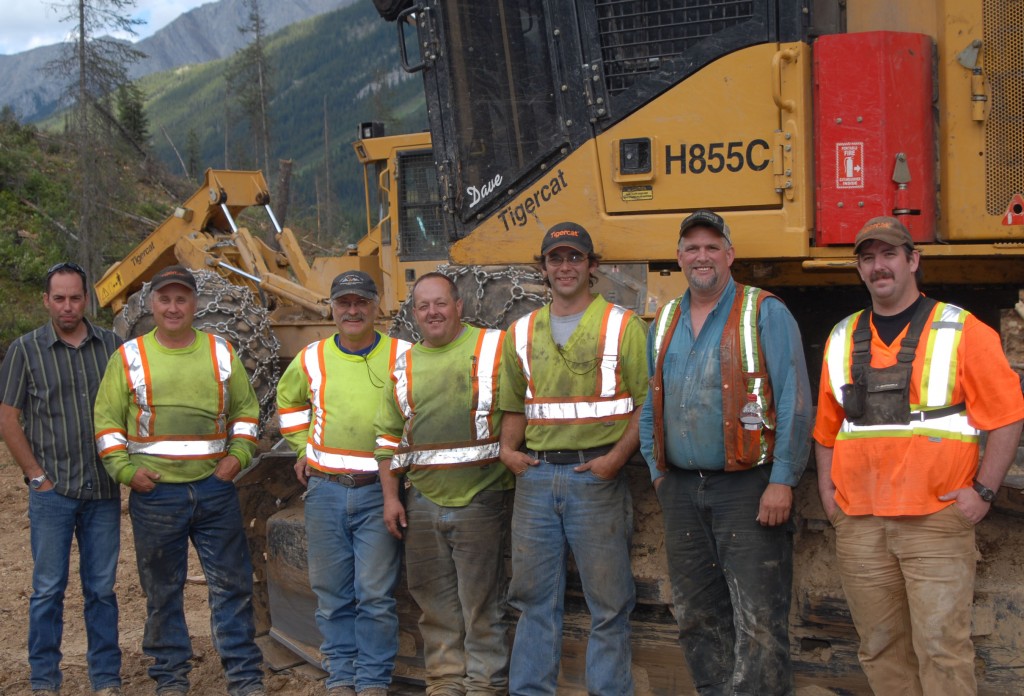
Parker-Pacific branch manager for Cranbrook, Dale Felhauer (far left) with the crew of Carl Larson’s Enterprise Ltd. (L-R) Lance Larson, Ivar Larson, David Deveau, Jory Langridge, Bob Findlay and George Barbour.
The family logging dynasty’s latest incarnation, Carl Larson’s Enterprise Ltd based in Canal Flats in southeastern BC was started in 1977 by Lance, Ivar and their father Carl. Ivar has been hand falling since 1971 and continued in this line until the company first began to mechanize in 1994 with an excavator paired to a Hultdins grapple saw. In 1996, Larson’s Enterprise bought its first purpose-built feller buncher, a non-leveling Timbco 415. In 2005, the company’s felling side progressed still further with the purchase of its first Tigercat piece. The LX830C feller buncher has proven to be a machine very well matched to the company’s operating conditions, limiting Ivar’s hand falling duties to the occasional steep drop-off or rock ledge.
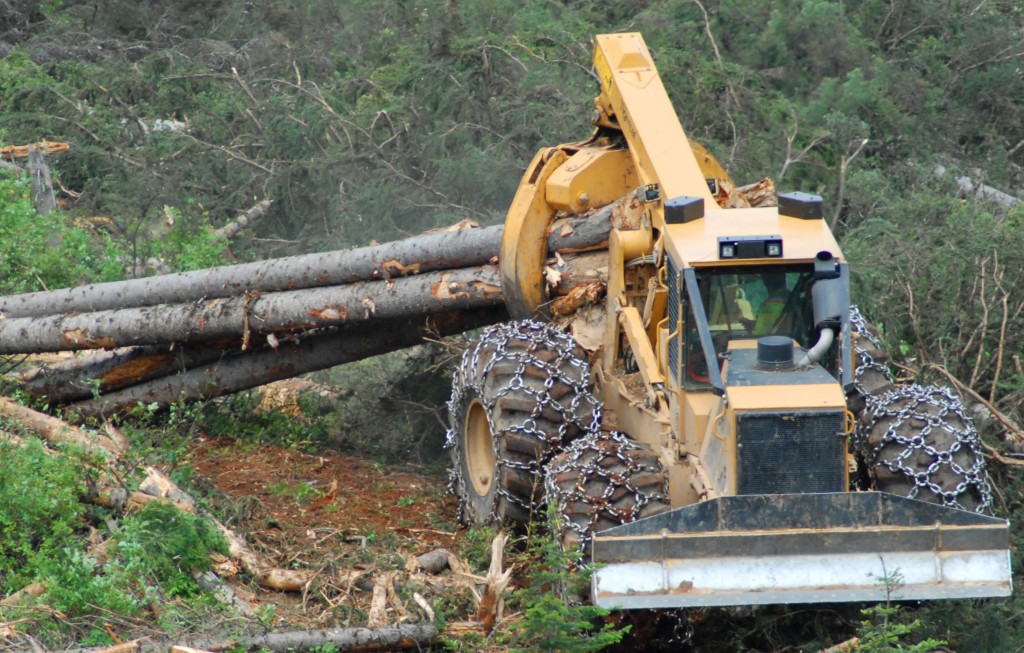
Jory Langridge builds a bunch on a steep hillside. Between travelling up the hills in reverse, building bunches and sorting and decking, he spends a lot of time in the rear facing position.
The Larsons deal with Parker-Pacific, Cranbrook for their Tigercat machines and have recently purchased a second LX830C, finding it to be an optimal machine for the area. It is equipped with a 5702 saw with a high rotation wrist, which helps build better skidder bunches with less travel. Observing the machine in action, it is obvious that the carrier and saw combination handle the wide variety of tree sizes well.
The machine bunches smaller stems effectively and can easily handle the half cubic metre (approximately half ton) stems at the larger end of the scale. The zero tail-swing provides additional leveling capability over a full tail-swing machine and increased agility for the occasional selective cut.
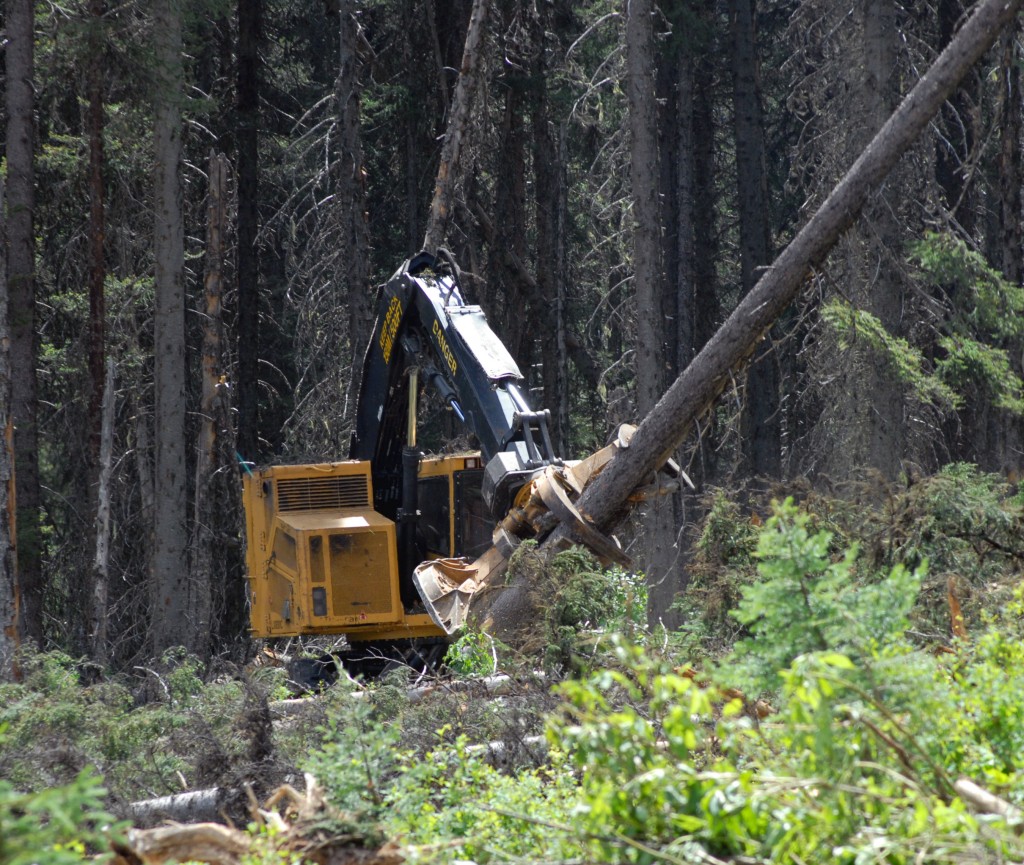
The LX830C feller buncher handles bigger timber and steep slopes equally well. The zero tail-swing allows the Larsons to work in clear fell and selective cutting as required without sacrificing stability or production.
These days Larson’s Enterprise produces for Canfor, operating on an annual volume of 150 000 cubic metres of tree-length timber with a crew of five. Bob Findlay operates the new LX830C feller buncher. George Barbour and Jory Langridge run E620C and 630D skidders respectively. At roadside is a Tigercat H855C processing four or five tree-length sorts. Ivar hops on the loader to perform sorting and decking duties around the congested and busy roadside landings, which are often size constrained by challenging site topography.
The annual production is achieved in four ten-hour shifts and a single eight-hour shift per week with spring break-up lasting approximately one month. There are generally four sorts — spruce, balsam, larch and pine — and daily production is range bound between ten and fourteen 50 m3 (approximately 55 ton) loads. Ivar intimates that Canfor is duly impressed with the production that the Larsons can squeeze out of a five-man crew and offers a clue to the company’s success. “The guys are the most important part of our operation… We are taking the whole crew on a fishing trip. I told them, ‘You are going because you are doing a good job for us.’ They are why we get 150 000 metres with a crew of five.”
Of course the song never remains the same and with Canfor’s recent expansion into the east Kootenays, the Larsons are currently in the midst of a transition to short wood. Their initial attempt resulted in a 30% reduction in processor productivity but Ivar and Lance expect that number to improve. However, the high number of sorts combined with the short wood directive will likely result in a requirement for additional processing capacity.
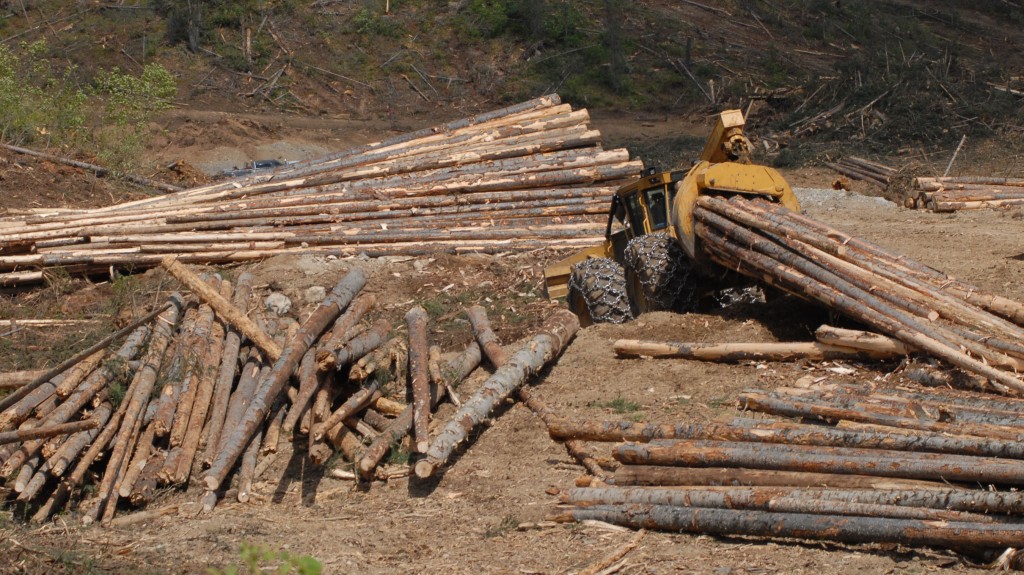
The 630D helping out with sorting and decking.
Ivar comments on his purpose-built roadside machine, which is priced higher than the typical converted excavator: “I like the H855C. It can buck more than an excavator. Some people don’t believe me and that is just fine with us. It gives us an advantage. I also like that it is made in Canada. It’s like it’s ours.”
One unique aspect of the operation is the degree to which the skidders are contributing to the decking and sorting functions. Jory Langridge is taking full advantage of the Turnaround™ feature to help with decking and sorting duties in between pulls. In fact, the Larsons installed a cutting edge and top deflector over the blade to augment the machine’s decking and brush cleaning abilities.
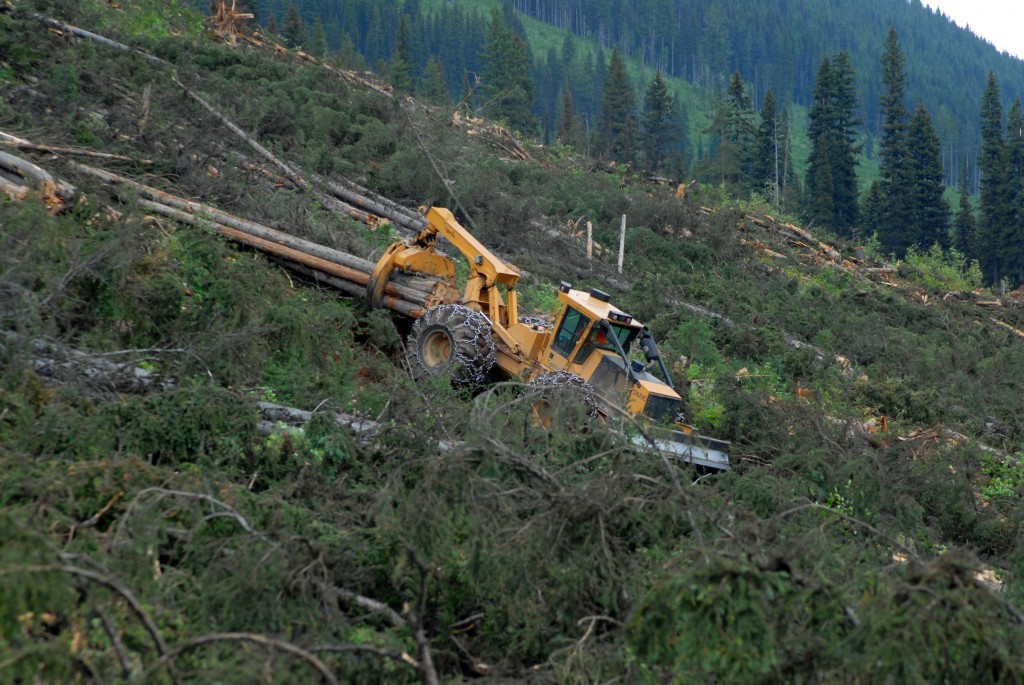
“When I’m dealing with sorts when the loader is not around, I don’t have to look over my shoulder. No more neck strain,” explains Jory. “I can grab a bunch in the middle and swing it right up onto the deck and I can pick up and heel 56 foot logs when sorting. The seat is always turned around.”
Jory is also impressed with the blade-down drive power when moving brush and cleaning up the deck area. “It pushes like a D6. I could build my own skid trails if I wanted to.” Although, looking up at the steep mountain face that Jory and George are working on, it is evident that there really are no skidder trails.
With nearly twenty years of industry experience, Jory has been a full-time machine operator since age seventeen and has worked for the Larsons for five years. Like Lance and Ivar, he is a third generation logger. He and George pilot their skidders in some pretty gruelling and just-plain-scary terrain.
“Sometimes you can’t just back up to a drag; you’ve got to come in from the side or even drop down from the top.” Jory, who is not afraid to grab a bunch in the middle and swing it around to the next skidder bunch, also explains that they installed wider blade extensions. (The blade is almost the width of the machine with 35.5 tires.) “It helps improve stability on side hills. I love the steep stuff,” he says. Operating on the western edge of the Canadian Rockies, there is no shortage of steep stuff.
Jory’s general impressions of the 630D include the observation that it is much smoother to operate and can hold more wood than any other four wheel skidder. “It has very strong grapple power — they don’t lose wood.” Regarding travel speed he comments that, “The D is even faster than the E620C which was way faster than the old 630B skidders.”
He also appreciates the balance between the power and stability of the machine. “The 630D can pull more than other skidders without standing up the front end or running out of power or heating up. It never hesitates or bogs down when pulling out of a bottom.” He also comments on the precision of the electronic-hydrostatic drive system. “You can adjust your trim so that you can move an inch — it can inch up a hill.”
Although George’s E620C is not Turnaround equipped, Jory’s is, and he uses the feature to its fullest potential. “When backing up the hill, it allows you to look at the lay of the land and pick your path. You can see roots and stumps,” he says. “After a ten-hour day, I feel so much better. I would go mining before I went back to a skidder without a Turnaround seat. There is nothing else like it.”
For someone who has only operated conventional skidders, Turnaround might at first seem to be a radical departure: the operator has one drive pedal at the front of the cab and one pedal at the rear of the cab. Forget forward and reverse – a direction selection switch on the joystick determines if the machine will travel blade-first or grapple-first. The computer system automatically adjusts the controls based on which direction the seat is facing, so when the operator is facing rear, and selects ‘forward’ direction, he will travel grapple first. (The joystick steering operates the same way.)
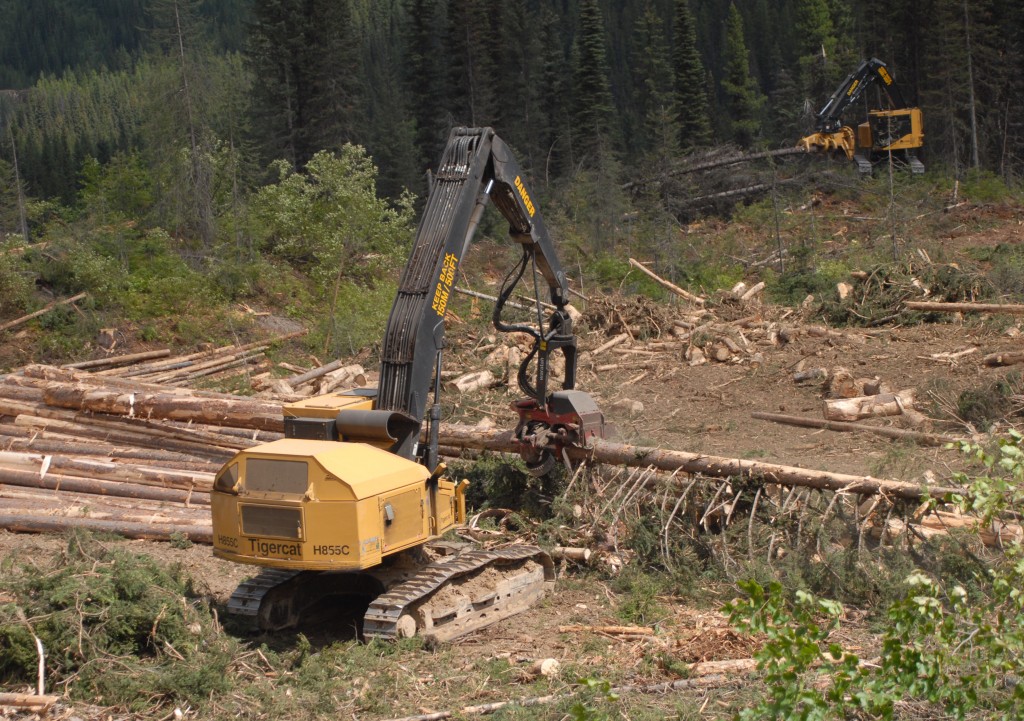
The H855C processing long lengths in 0,34 m3 average piece size.
Asked to comment on the learning curve, Jory responds, “It only took a week to feel right at home with it. The joysticks were not an issue at all because I’ve run excavators before.” Now with 1 300 hours of seat time under his belt, Jory is doing some pretty innovative stuff with Turnaround.
He often turns the seat from forward to reverse and back again very quickly when he has to perform a quick task with the grapple or if he wants to see something behind him. On steep slopes and complex terrain, he positions himself according to where he needs to see the most and will often switch back and forth while driving using gravity or the momentum of the machine to turn the seat. The machine, of course, never stops travelling in the desired direction. To achieve this, Jory hits the direction selection button in mid-turn so that the direction of travel stays the same once the seat locks into the opposite position. “You’ve got to think outside the box,” he says.
Ivar and Lance run a tight, efficient operation and by the sound of it, they have developed a good relationship with Canfor right from the start. While the switch over to short wood may prove challenging in the transition, they are certainly equipped with the crew and machinery to make a success of it.